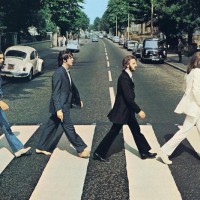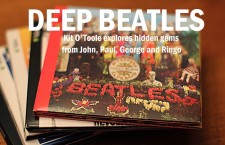Concluding our walk through the Abbey Road medley is the brief, secret coda “Her Majesty.” At only 23 seconds, it stands as the shortest song in the Beatles catalog. However, it exemplifies composer Paul McCartney’s gift for melody, and provides a cheeky ending that winks at the audience. Her Majesty may not have had a lot to say, but the song and its formation speaks volumes.
The track began life as a song fragment that McCartney brought to the Let It Be sessions at Twickenham Studios. Written during a Scotland holiday, he introduced “Her Majesty” to the other Beatles on January 9, 1969. His initial effort featured McCartney playing piano while humming some of the yet-to-be-completed lyrics.
About two weeks later, the group returned to the track, this time back at Apple Studios. By then, McCartney had slightly revised the lyrics, although he seemed to be playing with the words in the embedded recording here. In this January 24 version, McCartney remained on piano and sang in falsetto; John Lennon joined in on slide guitar; and Ringo Starr can be heard trying out drum patterns. While George Harrison’s guitar cannot be heard in this outtake, his voice is present — he repeatedly calls out for band assistant Mal Evans.
Interestingly, “Her Majesty” takes on a country twang in this version, quite different from the minimalist arrangement of the final take.
Once the Beatles decided to shelve the Let It Be sessions (at this point still called the “Get Back Tapes”), they did not return to the work-in-progress “Her Majesty” until July 2, when McCartney recorded the final version of the track at Abbey Road Studios. He laid down three takes, with the third judged the best. The initial version featured a full ending, as heard in the clip at bottom.
At this point, the band intended to fit the song fragment within the medley, sandwiched between “Mean Mr. Mustard” and “Polythene Pam.” Evidence of this plan exists at the beginning and end of “Her Majesty” — the crashing chord stems from the ending chord of “Mean Mr. Mustard” (probably taken from a previous mix), while the abrupt end was meant to segue into “Polythene Pam.” Once completed, McCartney joined Harrison and Starr to record “Golden Slumbers/Carry That Weight.” Lennon did not participate in these sessions, as he was still recovering from a car accident. When McCartney heard the proposed medley edit, with “Her Majesty” inserted in between “Mean Mr. Mustard” and “Polythene Pam,” he decided the songs did not mesh together well. Judge for yourself by listening to a recreation of this proposed medley, which follows.
After hearing this version, McCartney ordered engineer John Kurlander to remove “Her Majesty” from the lineup. According to Mark Lewisohn’s Complete Beatles Recording Sessions, Kurlander did so but forgot to remove that final stray note at the end of the track. He then secretly kept the fragment and, without McCartney’s knowledge, later appended it to the conclusion of medley. After hearing the revised medley the next day, which now featured “Her Majesty” as a “hidden track,” McCartney approved the change. “The Beatles always picked up on accidental things. It came as a nice little surprise there at the end, and he didn’t mind. We never remixed ‘Her Majesty’ again, that was the mix which ended up on the finished LP,” Kurlander told Lewisohn.
In 1969, McCartney explained that he wrote the song “as a joke.” Indeed, the lyrics are sassy and suggestive, poking good-natured fun at the monarchy. At first he softly sings “Her Majesty’s a pretty nice girl, but she doesn’t have a lot to say. Her Majesty’s a pretty nice girl, but she changes from day to day.” He wants to break through this aloofness, but he’s “got to get a bellyful of wine” before doing so. Appearing before the Queen while drunk reinforces the Beatles’ rebellious attitude toward societal conventions, and even typical Liverpudlian humor, also known as “taking the mickey” out of someone. McCartney concludes with the line “Her Majesty’s a pretty nice girl, someday I’m gonna make her mine.” Now the track has taken another turn, this time away from simple irreverence and more toward affection. He has softened the blow, illustrating how the Beatles deftly skirted around the edges of censorship; they could challenge norms yet retain their accessibility and ultimate commercial force.
McCartney’s acoustic guitar fretwork also stands as an under-appreciated aspect of the song. Similar to tracks such as “Blackbird,” he demonstrates an impressive ability to play delicate yet intricate chords and notes, establishing rhythm and melody in his understated style. As both a bassist and guitarist, McCartney deserves to be ranked among rock’s best all-around musicians.
“Her Majesty” may last less than 25 seconds, yet it serves as a fitting coda not only for the Abbey Road album, but for the Beatles’ career. They gave fans one more taste of their humor, lightening the intense emotion expressed in “The End.” Their wit, playfulness, and tuneful qualities are wrapped up in one song fragment that came close to remaining on the cutting room floor.
- The Rescued Early Paul McCartney Song That Completed ‘Beatles For Sale’ - December 4, 2024
- A Rare Beatles Cover Proves John Lennon Was Wrong About His Voice - November 26, 2024
- How John Lennon Came Roaring Back on the Beatles’ White Album - November 22, 2023




Thanks, Kit, for this series on the Abbey Road medley. The music was strongly affecting at the time, and it’s even more so with all the detail and analysis you’ve contributed. Very nice work on your part.